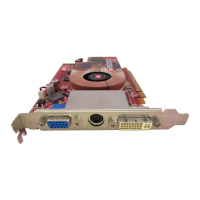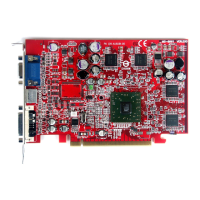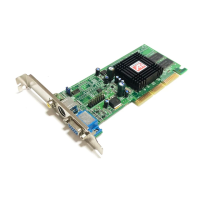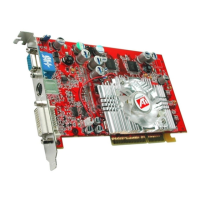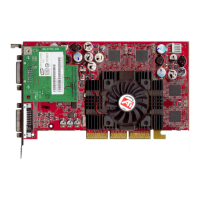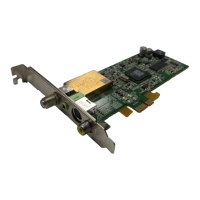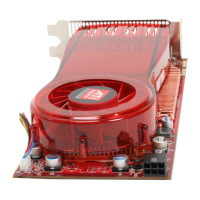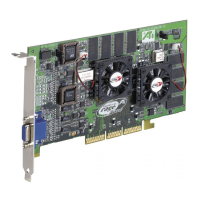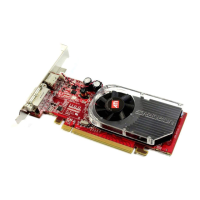
Do you have a question about the ATI Technologies X1300 - Radeon 256 MB PCI Express Video Card and is the answer not in the manual?
| Brand | ATI Technologies |
|---|---|
| Model | X1300 - Radeon 256 MB PCI Express Video Card |
| Category | Video Card |
| Language | English |
Details the hardware and software features of the Radeon X1300 Series graphics card.
Lists the hardware and software prerequisites for installing and operating the graphics card.
Covers essential steps and warnings to follow before starting the installation process.
Provides instructions for removing existing graphics drivers to ensure a clean installation.
Explains the different types of expansion slots (AGP, PCI, PCIe) for graphics cards.
Outlines the standard procedure for installing the graphics card without external power connections.
Details the advanced installation steps for AGP cards requiring a separate power connection.
Details the advanced installation steps for PCIe cards requiring a separate power connection.
Illustrates and describes the various connectors on the graphics card for monitors and TVs.
Explains how to connect single and multiple monitors, including TV Out configurations.
Lists and describes various display configurations supported by the graphics card.
Guides users through the process of installing drivers and software for Windows XP.
Explains how to configure monitor settings after driver installation.
Provides steps for reinstalling graphics drivers if conflicts arise.
Details the installation process for the Catalyst software suite, including its components.
Describes various methods to launch the Catalyst Control Center application.
Explains the graphical dashboard and its role in managing display features.
Details the different views (Basic, Advanced, Custom) within the Catalyst Control Center.
Covers creating and managing custom keyboard shortcuts for quick access to functions.
Explains how to create, save, and activate custom profiles for display settings.
Describes how to adjust general preferences like tooltips, skins, and tray icon visibility.
Provides details about installed graphics hardware and software versions.
Centralizes configuration for display devices and desktop arrangement.
Offers advanced control over display settings like refresh rates and detection.
Allows configuration of monitor attributes and display of connected monitor information.
Covers DVI settings and image scaling for digital displays like HDTVs.
Enables per-display color adjustments for hue, saturation, and temperature.
Details how to add HDTV modes not initially listed due to incomplete EDID.
Manages settings for 3D applications, including anti-aliasing and filtering.
Provides a universal slider for simultaneous adjustment of standard 3D settings.
Explains techniques to smooth jagged edges for better image quality or performance.
Describes adaptive anti-aliasing for improved edge smoothness and fine detail.
Preserves surface detail at varying distances for realistic 3D scenes.
Optimizes 3D application performance using texture analysis technology.
Adjusts texture detail for performance or image quality balance.
Combines principal 3D features for quick access and adjustment.
Allows selection of settings exclusive to Direct3D or OpenGL APIs.
Adjusts color properties of desktop and full-screen 3D applications.
Helps detect and recover from graphics processor hangs to prevent system crashes.
Explains how to use the TV Out capability of the graphics card.
Details how to connect the graphics card to a TV using S-Video or composite cables.
Guides users on connecting to High Definition Televisions for enhanced viewing.
Outlines the necessary hardware components for a CrossFire system.
Lists motherboards that are compatible with the CrossFire technology.
Explains specific CMOS settings required for CrossFire functionality.
Details software settings within Catalyst Control Center needed for CrossFire operation.
Describes the physical connection method for graphics cards in a CrossFire system.
Lists games and applications that are compatible with CrossFire technology.
Clarifies if driver profiles are necessary for CrossFire functionality.
Explains the operational behavior when mixing different pipeline count graphics cards.
Details available rendering modes and their benefits for CrossFire systems.
Explains how rendering modes are selected, especially with Catalyst A.I. enabled.
Describes the expected performance enhancements when using CrossFire.
Outlines the number of displays that can be connected to a CrossFire system.
Provides common problems and their solutions for graphics card installation and operation.
Explains the process of registering the product with ATI for customer care.
Lists contact options and procedures for obtaining customer support.
Information on where to purchase additional accessories and replacement parts.
Details FCC and CE compliance information for the product.
